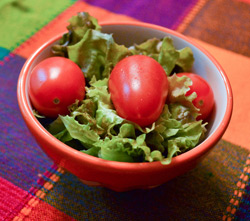7 Tips for “Eating Slim”


by Deborah Orlick Levy, MS, RD
Fueling your body with proper nutrition is the most important component to a healthy lifestyle. How we look and feel is important too. So, whether you’re aiming to lose a few pounds or concerned about unhealthy eating habits, these simple steps will help make a life-long impact on your weight.
1. Include lean protein and fiber at each meal.
Studies shows that protein foods increase satiety and decrease appetite resulting in fewer calories consumed. Fiber-rich foods are digested slower than other foods so you stay fuller longer. But, be aware, if you increase protein and fiber, you must also increase water intake or you may become constipated. So, have your egg whites with whole wheat toast and your whole wheat pita bread with vegetables and grilled chicken and but don’t forget the extra glass of water.
2. Switch out your plates, bowls and utensils.
Did you know that many people overeat because our eyes make the decision for our stomach on how much to eat? When we use larger plates and bowls, we serve ourselves a larger amount of food to fill up the space on the dish. Fooling our eyes and taking smaller dishes can save hundreds of calories at each meal. And, by using a smaller fork and spoon, it takes longer to eat because you can’t fit as much on the utensil each time you dig in.
3. Choose spaghetti squash over pasta in all your favorite dishes.
Spaghetti squash is named because when cooked, it separates into strands that look like spaghetti. It is also a good source of nutrients, including fiber and vitamins A and C. One cup of cooked pasta has over 200 calories versus one cup of cooked spaghetti squash which has only about 40 calories. It’s simple to make, too. After you cut off the top and bottom of it, slice it lengthwise. Then, place it face down on a nonstick pan and bake for about 40 minutes on 350° until its flesh can be easily pierced. Or, place face down in microwave safe dish with about one inch of water and microwave on high for about 10-15 minutes. Microwave times vary based on power and size of squash.
4. Enjoy a broth-based soup or green, leafy salad before a meal.
Research shows that eating a low-calorie appetizer such as a broth-based soup or a green, leafy salad with a low-calorie dressing such as balsamic vinegar or lemon can help you consume fewer calories in the entire meal. Why? You’re starting to fill up stomach space with lower calorie foods and, especially when dining out, you give your stomach the 20 minutes it takes to begin to signal to the brain that it’s no longer as hungry so you will eat less of the main entree.
5. Avoid any food that’s fat-free except dairy products.
When fat is removed from foods it is usually replaced by sodium, sugar, sugar alternatives or carbohydrates. So, in avoiding the fat, you’re loading up on other unhealthy nutrients. Fat free potato chips contain olestra, which comes with a warning label that you may experience severe abdominal pain and cramping. Fat free cookies are high in sugar and carbohydrates so there is no feeling of satiety and people tend to overeat them. Fat free mayonnaise and ranch dressings are replaced with gums, sugars and starches that make them highly processed and unhealthier than smaller amounts of the same products that contain fat. However, dairy products are the exception. When fat is removed from dairy products, no additional ingredients are added. They are a rich source of many essential nutrients, including protein and calcium. This makes fat-free dairy the healthiest choice. Since fat in all other foods helps to keep you feeling satisfied, the removal of all fat from a food will likely result in over-consumption with increased caloric intake. The protein in the dairy food helps to curb your appetite and feel satisfied. The key idea is to eat a small amount of any other food that is full fat. You will be satisfied by the flavor of the food and eating less will be easy.
6. Stick to the 3 bite rule.
Studies show that people have heightened awareness of the first and last tastes of creamy, rich, highly caloric desserts. If you use a small utensil and allow yourself to enjoy, on occasion, 3 bites of a tempting dessert, you will enjoy a first and last bite while limiting the number of calories consumed from what’s left in the middle. It’s that simple… 3 small bites.
7. Cook with Coconut oil.
Coconut oil is a great alternative to vegetable oils because it is high in medium chain triglycerides, which are easily metabolized in the liver. This means they are less likely to be stored as fat in the body than other longer chain vegetable oils that undergo a more lengthy metabolization process. A study in the Journal of Lipids showed that women with a waist size higher that 35 inches who followed a low-calorie diet and exercised daily saw their good cholesterol levels (HDL) go up and their waist/belly fat decreased more significantly than those using a different oil. Remember that all cooking oils, including coconut, have around 130 calories a tablespoon. So, exercise and eat healthier by switching to coconut oil, but limit to no more than 1-2 tablespoons a day.
About the Author: Deborah Orlick Levy, MS, RD, is a registered dietitian with a Masters Degree in Clinical Nutrition. For more than 20 years, Deborah has counseled individuals and families to manage their weight and various health concerns including weight loss, eating disorders, food allergies and sports nutrition. She creates individually tailored nutrition and lifestyle programs to meet their unique needs. Find out more: healthaboveall.net and follow @healthaboveall
Photo Credits: Top image by DocteurCosmos. Bottom Image by Heather Katsoulis




